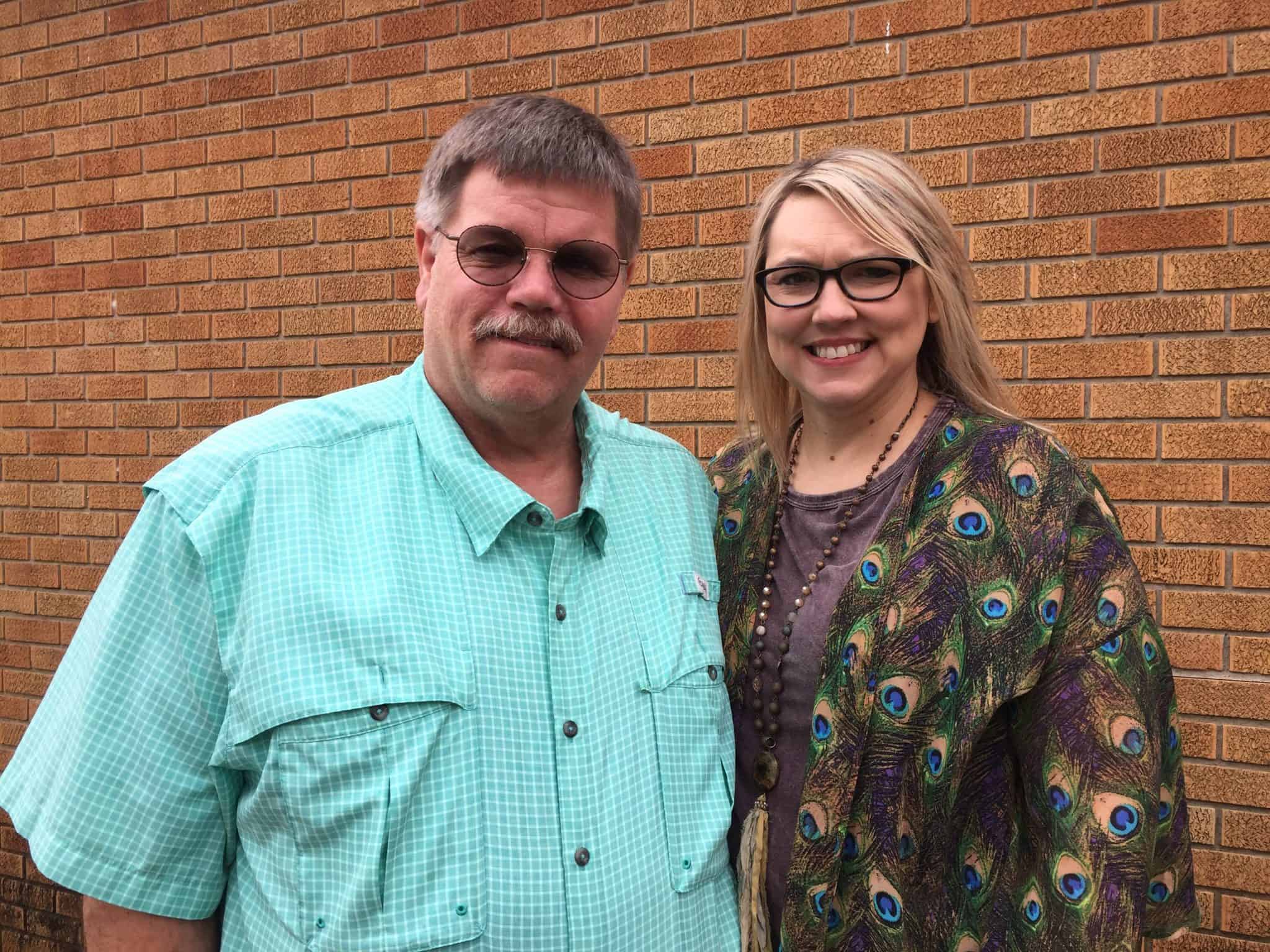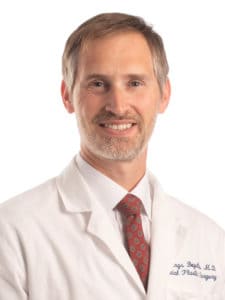View Larger Image

David Miller and his wife, Jennifer, about 4 months after the accident.
ENT Surgeon Reconstructs Man’s Face After Gun Explodes
| When 53-year-old David Miller of Beebe arrived at the University of Arkansas for Medical Sciences (UAMS) on the evening of Nov. 12 by Med Flight helicopter, the left side of his face was protruding several inches beyond the rest of his head.
Hours earlier, he and a friend were in a pasture outside Newark preparing for deer season, when he test-fired his .270-caliber rifle, as he’d done many times over the past decade. But this time, the gun exploded, spinning off a steel bolt about 6 inches long.
The linear piece of metal nearly an inch in diameter, its handle freed by the force of the explosion, sped through the air with such velocity that when it hit Miller’s face just under his nostrils, it pierced the skin and entered his head. There, it ripped through tissue, shattering his left cheekbone and eye socket, before exiting under his left ear.
Amazingly, the bolt continued on, slamming next into the chest of Miller’s friend, who stood about a foot behind him, hard enough to leave a bruise and collapse one of the man’s lungs.
While the other man lay on the ground, unable to get up, Miller used his cellphone to call for an ambulance, then called the owner of the property to describe the men’s location for the ambulance driver.
The men were rushed to the nearest hospital in Batesville, where his friend’s lung was repaired. But Miller’s injuries were so severe that he required transport by helicopter to UAMS in Little Rock, the state’s only adult Level 1 Trauma Center. Treated by both trauma and intensive care teams, Miller remained on a ventilator in the ICU for two days.

Jennings Boyette, M.D., operated to repair the extensive damage to David Miller’s face.
Jennings Boyette, M.D., a facial plastic surgeon and associate professor in the Department of Otolaryngology – Head and Neck Surgery in the College of Medicine, said because of the extent of Miller’s injuries and the intense swelling, he didn’t examine him until six days after the accident, when it was safer and easier to access the injured area.
“Anytime someone has severe trauma to their face and the adjacent structures, we can fix what goes wrong with their bone and their soft tissue and make them look better. But when you get hit that hard, you have to worry about a brain injury, a spine injury or an eye injury,” Boyette said.
“They thought I’d be blind in the left eye,” Miller said. He said doctors were also afraid he might lose part of his hearing. But neither situation materialized.
Boyette said that despite the unusual manner in which Miller was injured, the actual surgery wasn’t complicated. He noted that because of UAMS’ trauma center status, he regularly performs surgery on patients with similarly severe injuries due to car accidents and other emergencies.
He said that his department performs surgery on about 300 facial fractures a year, though the majority of the fractures they treat don’t require surgery.
In Miller’s case, Boyette said, “His cheekbone was fairly displaced out to the side — it was pushed out several inches — which opened up his eye socket, making a bigger eye socket.”
“A lot of the bone and the connections of that bone to his upper jaw, to the rim of his eye socket into his skull, were just kind of broken into little pieces. So the goal there was to put things back as normal as possible and try to get as good symmetry as possible without burning a lot of bridges on the way in.”

Some puffiness in his left cheek and some puckered skin right under his nose are the only remaining signs of David Miller’s accident.
It took several incisions just to get in, Boyette said.
“I always make a small incision in the eyelid that’s basically invisible when you open up your eye. I go through the inner part of his eyelid to get down to the rim of his eye socket, with the intent being not to leave a scar or any evidence we were there.”
Boyette then made another incision under Miller’s upper lip to gain access to his cheekbone, again to avoid leaving a scar on the skin.
“Then I repositioned everything, using lots of different little titanium plates and screws to get him back where it should be,” Boyette said. “Hopefully, when you close everything up, it will heal. You shouldn’t be able to tell that he’s had surgery; that’s always the goal.”
Boyette said Miller’s upper jaw, his maxilla, had actually broken loose, so he reattached it using small pieces of metal, plates and screws. He said the titanium holds the pieces together and then, as time goes on, the bones heal and fuse back together.
Miller said he told his wife, Jennifer, that he expected to remain in the hospital for six weeks, but he was able to go home the day after the surgery and resume his work as a diesel mechanic.
“You’ve gotta get back up and go,” he said. “You can’t lie around too long.”
Less than two months later, Miller said he looked just like he did before, except for some puffiness in his left cheek and some puckered skin right under his nose. Boyette said after the swelling goes down completely, which could take as long as a year, the puckered area should be easy to restore to its normal appearance in an outpatient procedure.
Meanwhile, Miller has grown his first mustache to hide the small scar.
But overall, he said, “I feel great. I have no pain.”
Miller praised the doctors and nurses who took care of him physically and nurtured him with kindnesses, such as bringing him special foods that he could eat despite his injuries.
“You couldn’t ask for a finer staff of people,” he said. He called Boyette “a wonderful doctor,” noting, “He’s very good at his work, and he’s got a very good bedside manner.”
Miller said the accident didn’t stop him from hunting again. In fact, he said in early January, “I’ve already killed two deer since I got out.”
He said a gunsmith is trying to determine what caused the explosion through an examination of the recovered pieces, including the bolt handle that was found on the dashboard of his pickup, which had been parked nearby. The handle had come to rest there after piercing a hole in the truck’s back windshield and sailing through the vehicle.
“I was very fortunate.” Miller said. “The good Lord was with me that day for sure.”